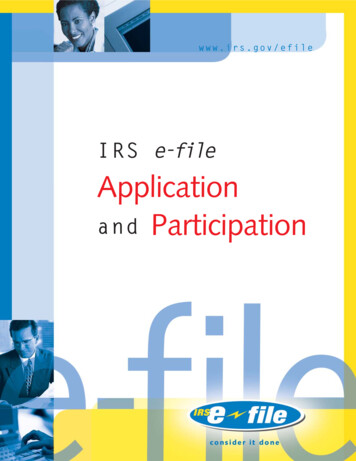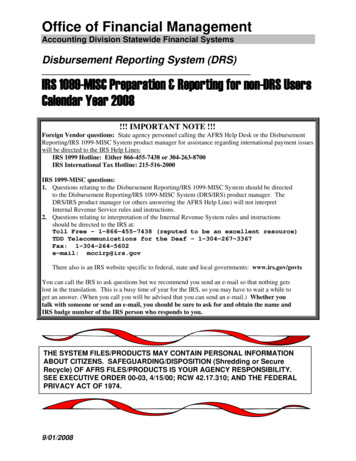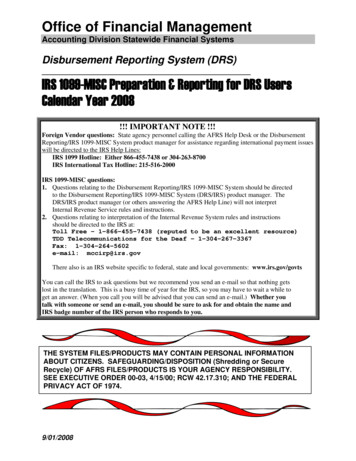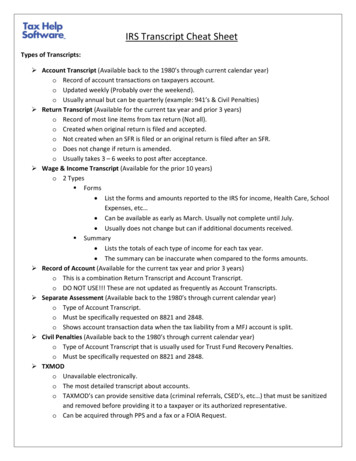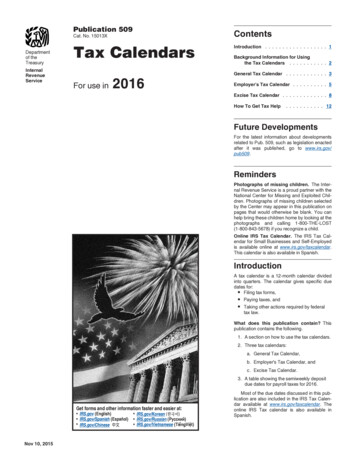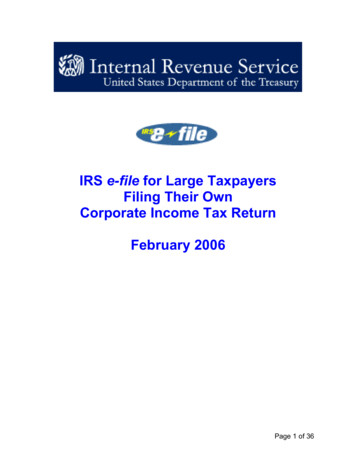
Transcription
IRS e-file for Large TaxpayersFiling Their OwnCorporate Income Tax ReturnFebruary 2006Page 1 of 36
Table of ContentsPage3Why do we have to e-file?Treasury Regulation ٭ Large Taxpayer Threshold ٭ Effective dates ٭ e-filingRequirement” ٭ Expansion to All Large and Mid-Size Corporations4-5What is Modernized e-file (MeF)?Internet e-filing ٭ XML Standards ٭ Benefits6-9What’s the process to e-file?Individual Registration ٭ Creating Your Corporate e-file Application ٭ ResponsibleOfficials and Delegated Users ٭ Authorities10-21What’s different in preparing my return to e-file?Software Developers ٭ Consolidated Returns ٭ Stacked Returns ٭ Supporting Data ٭ Form 8865 ٭ Disclosure Statements ٭ Elections ٭ General Dependency Election ٭ Plansof Merger ٭ Plans of Reorganization ٭ Meeting Notes ٭ Separate Signature Lines ٭ Form8838 ٭ Updating Addresses ٭ Foreign Addresses ٭ Foreign Country Code ٭ DomesticAddress Changes ٭ Foreign Address Changes ٭ Standard Street Abbreviations ٭ ValidZip Codes ٭ Name Control ٭ Business Activity Codes ٭ Converting to XML Format ٭ XMLSchemas ٭ Signing your return ٭ Forms 8453-C and 8453-S ٭ Changing Return Data22-30How do I get my electronic return to IRS?Transmission Channels ٭ Internet Filing Application (IFA) ٭ Check Sum ٭ Application-toApplication (A2) ٭ Direct Transmission ٭ Third-Party Transmitter ٭ Online Provider ٭ ٭ Receipts and Acknowledgements ٭ Security31- 33How are refunds and balance due returns handledelectronically?Refunds ٭ Balance Due Returns ٭ Electronic Funds Withdrawal ٭ Credit Card Payments ٭ Electronic Federal Tax Payment System (EFTPS) ٭ Paying by Check34What is considered a timely filed electronic return?Electronic Postmark ٭ Transmission Perfection Period ٭ 35What publications or information are available to help meunderstand the e-file process?Publication 4162 ٭ Publication 4163 ٭ Publication 4164 ٭ irs.gov Frequently Asked Questions ٭ large.corporate@irs.gov * Quick Alerts ٭ Screen shots: e-Services’ Registration and e-file Application for Large Taxpayers36What are the record keeping and document retentionrequirements?Electronic Return Requirements ٭ Acknowledgement FilePage 2 of 36
Why do we have to e-file?On January 11, 2005, the Internal Revenue Service issued temporary Department ofthe Treasury Regulation Section 301.6011-5T. This regulation requires electronicfiling of Forms 1120 or 1120S for tax years ending on or after December 31, 2005 forcorporations with assets of 50 million or more and who file at least 250 returns in a taxyear. The determination of whether a corporation is required to file at least 250 returnsis made by aggregating all returns (regardless of type) that the entity is required to fileover the calendar year. Examples include income tax returns, returns required underSection 6033, information returns, excise tax returns and employment tax returns. 50 MILLION IN ASSETS AND 250 OR MORE RETURNS FILED“Returns Filed” includes an aggregate of Income tax returns Returns under Section 6033 Information returns Excise tax returns Employment tax returnsFORMS 1120 or 1120STAX YEARS ENDING ON OR AFTER DECEMBER 31, 2005The IRS asset range for Large and Mid-Size Corporations are businesses or otherentities with assets of 10 million or more, or a partnership with more than 100 partners,that prepares the electronic submission of its own return(s).The requirement to e-file will extend to corporations with assets of 10million or more for tax years ending on or after December 31, 2006!This document is written to provide information for corporations that are choosing toelectronically file their own corporate return rather than using an Authorized IRS efile Provider. An Authorized IRS e-file Provider is a company (or individual) that hasapplied, passed suitability and been accepted by IRS to e-file individual or businessincome tax returns. A list of Authorized IRS e-file Providers can be found on the irs.govwebsite (http://www.irs.gov/efile/lists/0,,id 119096,00.html ).Page 3 of 36
What is Modernized e-File (MeF)?Modernized e-File is an important component of IRS’s re-engineering efforts to improveservice, enhance enforcement, and modernize technology and work processes. It is aninternet-based system that uses standardized Extensible Mark-Up Language(XML) constructs that provides corporations the capability to electronically file Forms1120 and 1120S.IRS introduced electronic filing in the 1980’s, first providing the capability to individualwage-earning taxpayers. In each year since, a greater number of taxpayers haveelected to e-file, with over 50% of individual taxpayers e-filing in 2004. In 1998, as aresult of the IRS Restructuring and Reform Act, Congress set a goal that 80% of allreturns should be filed electronically by the end of calendar year 2007.To provide electronic filing for corporate taxpayers, IRS began development of MeF in2002. IRS worked with stakeholder groups that represented the corporate taxcommunity and electronic filing software developers to ensure that the needs oftaxpayers were fully understood. Stakeholder groups included representatives from theAmerican Institute of Certified Public Accountants (AICPA), Tax Executives Institute(TEI), Association for Computers and Taxation (ACT), Tax Technologies, Incorporated,Deloitte and Touche (D&T), Research Institute of America (RIA), Vertex User Group,CCH, Creative Solutions, and Intuit. Any issue or concern that could affect taxpayers incomplying with electronic filing requirements were discussed in depth, resulting in thesystem as it is built today. This stakeholder group worked closely with the IRS during allphases of design, development and implementation of MeF. IRS will continue to solicitinput from stakeholder groups as additional forms are added to the MeF system.MeF is one of the IRS’ top modernization projects and resides on the IRS’ new secureinfrastructure. MeF was implemented in February of 2004 and, to date, over 200,000corporations have e-filed! Most of these corporate e-filers have assets under 10million, although over 1,000 large and mid-size corporations have voluntarily switched toe-filing.Corporate e-file is not new in the realm of taxation – 21 of the 30 member countriesin the Organization for Economic Co-operation and Development (OECD)have systems in place for electronic filing of corporate income tax returns. Eight ofthese 21 countries have required the electronic filing of corporate returns: Austria,France, Hungary, Ireland, Italy, Mexico, Netherlands, and Spain.For the corporations that are required to e-file, IRS estimates that over 11,000corporations will e-file their 2005 tax year returns in 2006.Page 4 of 36
The benefits of the MeF system includeA standardized, universal language (Extensible Mark-Up Language [XML]) thateliminates software barriersThe ability for corporate taxpayers to file more quickly, easily and reliablyThe ability to validate business rules that perform analysis before the return isaccepted, allowing the taxpayer to correct their returnMore explicit error conditions -- New error code explanations pinpoint the locationof the error in the return and provide complete information in theAcknowledgement FileSubmitting a return in the most up to date internet security technologies toensure information confidentiality and data securitySafe, secure transfers of electronic funds via a number of different methodsA totally paperless process – supporting documents and transactional data areaccepted as Portable Document Format (PDF) documents along with the returnThe ability to electronically file complex returns such as consolidated returns withmultiple subsidiaries, foreign entities, and supporting dataFaster, more accurate processing, and quicker interactions between IRS andtaxpayersE-filed returns are processed as they are received and filers receive promptelectronic acknowledgements in near real time – no more waiting for once ortwice daily system processing cyclesIntegrated payment options – if you owe taxes, you can e-file a balance duereturn and, at the same time, authorize an electronic funds withdrawal from yourbank account (payments are subject to limitations of the Federal Tax DepositRules)When the forms listed below are included as part of a Form 1120/112S returnfiled electronically, the requirement to submit duplicate copies of the forms to thePhiladelphia Submission Processing Center (PSPC) is eliminated:¾ Form 5471---Information Return of US Persons With Respect To CertainForeign Corporations¾ Form 5472---Information Return of a 25% Foreign-Owned US Corporation ora Foreign Corporation Engaged in a US Trade or Business¾ Form 5713---International Boycott ReportPage 5 of 36
What’s the process to e-file?To e-file your return, there are three separate processes for you to complete:(1) Registration, (2) Creating an e-file Application and (3) transmitting your return toIRS. It is recommended that you complete the online registration and e-file Applicationprocess at least 45 days before you plan to file your electronic return and 60 days if youplan to transmit your own return (requires communications testing to ensure connectivitywith IRS)!In order to interact electronically with thousands of users, the IRS must authenticate aperson. Registration is a one-time, universal process that authenticates the individualregistrant to the IRS through the use of “shared secrets” and enables you to dobusiness electronically with the IRS. Registration is part of a suite of products on IRS’secure network known as “e-Services”.All Responsible Official(s) and Delegated User(s) within yourcorporation who will be responsible for e-filing your corporate returnand/or creating or maintaining your corporate e-file Application willneed to individually register with e-Services.To register, select the “Not yet registered?” link athttp://www.irs.gov/taxpros/article/0,,id 109646,00.html or follow the instructions below:1. At irs.gov, select the e-file logo2. Select the “e-Services” link under“e-file for Tax Professionals”3. Select “Registration Services” next to“Not Yet Registered?” (You will get a promptthat you are about to view information over asecure network.)You’ll need the followinginformation to register:NameAddressPhoneSSNDate of BirthAdjusted Gross Income(from your current or oneprevious tax year)4. Click on the “Registration” link and follow the instructions.Pay particular attention on how to construct your Usernameand Password. Remember to safely record these two items,along with the Username recovery question/answer and thefive-digit Personal Identification Number (PIN) you willcreate that represents your electronic signature!You will use this PIN to sign your corporation’s e-fileApplication!Page 6 of 36
5. After you successfully register online, the IRS will maila confirmation number to your official address of record.You will have 28 days from the initial registration to accesse-Services and input your confirmation number tosuccessfully complete your registration! You mustperform this step to complete the registrationprocess!!ConfirmationNumber6. Your e-Services password will expire every six (6) months.You will receive screen notices within 15 days of expirationand an e-mail within 10 days of expiration. Set a reminder toaccess e-services if you don’t have an e-mail or if you don’taccess the system periodically.If you want to look at instructions and the screens for registration, go to irs.gov andclick on “e-Services’ Registration Process.pdf “on the e-file for Large and Mid SizeCorporations article/0,,id rations/article/0,,id 146959,00.html)Now that you have successfully registered, you are ready to create your corporation’se-file Application.First, you must determine who will perform certain functions for your corporation andgather the necessary information to complete your Application. You will need to decide: Who will be your Responsible Official(s) (you can have up to five; it is a goodidea to have at least two for back-up purposes) and what authorities they willhaveWho will be your Delegated Users and what authorities they will haveWhat form(s) you will e-fileHow you will transmit your return (covered in a later section)Here are definitions that will help you determine who will act as your ResponsibleOfficials and Delegated Users.A Responsible Official is: An individual with responsibility for and authority over your e-file operationAn individual who is the first point of contact with the IRS and has the authority tocreate, revise and sign your e-file ApplicationAn individual who is responsible for ensuring that your corporation adheres to theprovisions of all publications and notices governing IRS e-file. (If one individualcannot fulfill these responsibilities, up to four additional Responsible Officials maybe identified [for a total of five])Page 7 of 36
An individual who is a U.S. citizen or legal resident alien (lawful permanentresident), and have attained the age of 21 as of the date of the applicationNote: The Responsible Official is not required to be a Corporate Officer ora Principal of the Firm!You will need the following information for each Responsible Official you want to add toyour corporation’s e-file Application: Name, Social Security Number, Title, Date of Birth,Position Title, and e-mail Address.A Delegated User is an individual within your firm/organization, other than aResponsible Official, who is an employee, partner, or other member of thefirm/organization or who has a business relationship with the firm/organization. Theinformation you will need for each Delegated Users you want to add to yourcorporation’s e-file Application includes: Name, Social Security Number, Title, and email Address.Your corporation will determine what “authorities” the Responsible Official(s) andDelegated User(s) can have. The Responsible Official that creates the corporation’s efile Application can authorize any or all of the following permissions for eitherResponsible Officials or Delegated Users:Authority to:¾ View the corporation’s e-file Application Information¾ Update the corporation’s e-file Application Information¾ Sign and Submit the corporation’s revised e-file Application¾ Add, delete or change Responsible Officials¾ Be designated as the corporation’s Internet TransmitterIt is important that ResponsibleOfficials and/or Delegated Users andtheir authorities be deleted from the IRSe-file Application when they are nolonger associated with the LargeTaxpayer or when their position withinthe firm no longer warrants one or moreauthorities.Page 8 of 36
There are two distinct differences in creating an e-file Application as a Large Taxpayerversus a Tax Practitioner:(1) because e-filing is required, you do not have to undergo suitability checksrequired of firms e-filing for profit (suitability checks are not performed on theResponsible Officials or Delegated Users of the corporation) and(2) you will be assigned both an Electronic Filing Identification Number (EFIN)and an Electronic Transmitter Identification Number (ETIN) on the completion ofyour e-file Application. Depending on how you transmit your return, you mayneed to use both your EFIN and ETIN when e-filing or just your EFIN. Theoptions for transmitting your return to IRS are discussed in greater detail underthe “How do I get my electronic return to IRS” section on “Transmitting YourReturn”.It is important to become familiar with the rules and requirements for participation in IRSe-file by reading the applicable IRS e-file documents. Publications and otherinformation about IRS e-file and related topics, including state filing information, can befound on the IRS web site at www.irs.gov and are also included in a later section of thisdocument. If you are experiencing problems as you create your e-file Application, youcan also call the IRS’ e-Help Desk toll-free at 1-866-255-0654 for assistance.Publication 3112 (Application and Participation in IRS e-file) describes the e-fileApplication process, but keep in mind that Large Taxpayers are not subject to theinformation on the suitability checks.Step-by-step instructions and every screen that you will see when you establish an e-fileApplication for your corporation can be found online at irs.gov. Go to “e-fle for Largeand Mid Size Corporations” and click on “e-Services’ e-file Application for s/corporations/article/0,,id 146959,00.html)Just as a reminder, when you are in e-Services, you are in a secure environment. Donot use your browser “back” or “forward” arrows! Use the navigation buttons on thescreens for “next” or “previous”!Page 9 of 36
What’s different in preparing my return to e-file?Most corporations have been using software to prepare their return for years. With therequirement to e-file, the challenge will be to integrate all of the supporting data,transactional data, elections, disclosure statements and other items with your return.These documents can be prepared in a variety of software packages; with paper filing,you would just attach the document to your return. This section discusses how tohandle these attachments. Complete instructions for all forms and potentialattachments are contained in Publication 4163, Modernized e-File Information forAuthorized IRS e-file Providers of Forms 1120/1120S.First, IRS requires all tax preparation software from Software Developers used forpreparing electronic returns to pass the requirements for MeF Assurance Testing (ATS)as briefly explained below:1. IRS issues Publication 4162, Modernized e-File Test Package for Forms1120/1120S (TY 2005), Rev. 10/27/05 that has a series of test tax returns andinstructions.2. Software vendors notify IRS that they plan to test and provide a list of forms theyplan to include in their tax preparation software.Note: IRS does not require software vendors to support all forms! They areallowed to develop their tax preparation software based on the needs of theirclients. The test returns issued by IRS also do not include all forms or schedulesthat can be part of an actual return! Please check with your software vendor onthe availability of the forms/schedules you need to e-file your return!3. Software vendors use the test tax returns to create test returns in the specifiedXML format.4. The software vendor transmits the XML formatted test tax returns to IRS.5. An IRS tax examiner checks every data entry field on the return.a. These checks ensure tax calculations on the test return matches theanswers provided by IRS on the test returns.b. These checks also ensure the software correctly formats the test taxreturn data in XML format and the data can be successfully transmitted to,received and the tax return viewed by IRS.6. When IRS determines the software correctly performs all required functions, thatsoftware is approved for electronic filing.7. After approval from IRS is received, software vendors are allowed to market theirtax preparation software to corporations and/or professionals as “approved forelectronic filing”.Page 10 of 36
When taxpayers prepare paper consolidated corporate income tax returns,spreadsheets are commonly used to report the required data for each subsidiary.These spreadsheets are commonly used to report subsidiary data on Form 1120, otherattached IRS forms such as Form 4562, and for supporting data (other incomestatement). These spreadsheets are attached to the consolidated return and mailed toIRS.MeF requires tax preparation software approved for electronic filing to use IRS forms forreporting data for each subsidiary return. In addition to the parent return, tax preparationsoftware approved for electronic filing should allow taxpayers to create a separate“stacked return” for each subsidiary. Tax preparation software should allow taxpayersto report Eliminations and Adjustments as a separate “stacked return”. Taxpreparation software may also allow taxpayers to use spreadsheets for the internalreview of the return, but IRS requires all subsidiary data to be formatted, transmittedand viewed by IRS as “stacked returns”.Taxpayers use tax preparation software to prepare most of their paper corporateincome tax return but may use other formats (Word, Excel, etc) to prepare supportingdata. The documents containing supporting data are then attached to the portion of thereturn prepared by tax preparation software and mailed to IRS.MeF requires supporting data to be included in tax preparation software or attached asscanned PDF files. IRS reviewed all of the forms (and instructions) that may beattached to Form 1120 and/or 1120S and identified every instance where taxpayers arerequired to attach supporting data. IRS provided structured formats to softwaredevelopers or provided instructions to enter supporting data as PDF files (in instanceswhere IRS has not defined a format). Software developers are required to use theseformats for developing tax preparation software approved by IRS for electronic filing. Itis the responsibility of software vendors to provide appropriate instructions for taxpayersto enter supporting data to meet the IRS guidelines. Most software vendors will allowtaxpayers to import/export data from other sources. Taxpayers are encouraged todiscuss available options with their software vendor early to determine how to preparesupporting data. The examples on the following pages will assist taxpayers inunderstanding how to prepare supporting data for electronic returns.Page 11 of 36
Example 1 – Supporting data required by IRS forms.IRS issued specific formats that software developers must use for this type ofsupporting data. In the example below, taxpayers must include (either by entering orimporting) data for the required “type” and “amount of income” as indicated in taxpreparation software instructions.From InstructionsLine 10 Other IncomeEnter any other taxable income notreported on lines 1 through 9. ListThe “type” and “amount ofIncome” on an attached schedule.Page 12 of 36
Example 2 - Supporting Data required by IRS form instructions.IRS issued specific formats that tax preparation software must use for supporting datarequired by form instructions. In the example below, taxpayers must include (either byentering or importing) required data for “description of property” and “depreciationmethod” as indicated by tax preparation software instructions.Page 4, Form 4562 Instructionsfor line 15 states:Page 13 of 36
Example 3 – Supporting Data required as another IRS form.In the following example, form instructions require the taxpayer to attach another IRSform or statement as supporting data. Line 2(a) and 2(b) require supporting data to beprovided using an IRS form; failure to use the required IRS form will cause electronicreturn to reject. Line 2(c) requires supporting data to be provided using an attachedstatement; taxpayers should always provide the supporting data.Page 14 of 36
Example 4 – Supporting Data required for tables on IRS forms.When required data exceeds number of lines provided on IRS forms, tax preparationsoftware will allow the taxpayer to continue to enter all necessary data instead ofcreating an attachment. When the electronic data is transmitted and processed thedata will be displayed as “repeating data” by MeF systems.Taxpayer data exceeds thenumber of lines provided onIRS forms.Page 15 of 36
In many instances, information on schedules attached to Form 1065 will be the sameschedules required to be filed with the Form 8865, Return of US Person with Respect toCertain Foreign Partnerships. If a taxpayer has already prepared the Form 1065 andhas completed Schedules B, D, K, K1, L, M-1, M-2, do NOT attach the Form 1065schedules to the return, instead, the data from the Form 1065 schedules should becopied to the corresponding Form 8865 schedules.When taxpayers prepare paper corporate income tax returns, they may not use taxpreparation software to prepare the disclosure statements and/or elections requiredby Treasury Regulations or various IRS Publications. Taxpayers often use a variety ofmethods (Word, Excel, Election programs) to prepare the numerous disclosurestatements and/or elections based on the unique needs of the particular return.MeF requires all disclosure statements and elections to be included with the return inthe specified format. Temporary Treasury Regulation 9100 eliminates the requirementfor a separate signature for certain elections and/or disclosure statements. See T. D.9100 for a complete list.Taxpayers will use a General Dependency Election record to report most of theirdisclosure statements and elections. Tax preparation software approved for electionsfiling should provide instructions for taxpayers to complete the General DependencyElection. This record allows taxpayers to identify the disclosure statement/electionusing the following data elements Form Line or Instructions Reference (optional)Regulation Reference (optional)Description (optional)Attachment Information (optional)Below are examples that should assist taxpayers in planning for their disclosurestatements and elections as part of an electronic return.Page 16 of 36
Example 1 – General Election StatementSection XXXXElection for AAAAAAAAAAAAAAAAAAAAAAAAAAAAAAAAAExample 2 – General Dependency with Multiple AAAAAAAAAAAAAAAAAAAAAAAAAAAAAAAAASubsidiary # 1Subsidiary # 2Subsidiary # 3IRS provided specific formats that must be used for developing tax preparation softwareapproved for electronic filing for the following elections: Election # 1Election # 2Election # 3Some disclosure statements and/or elections may require supporting data which cannotbe entered into the specified formats (i.e. Plans of Merger, Plans of Reorganization,meeting notes, etc) This type of supporting data may be exported to the appropriateform if your software supports it or scanned and attached to the electronic return as aPDF file. The actual disclosure statement and/or election must be entered into therequired format and only the supporting data submitted as PDF.Many forms that may be attached to Form 1120 and 1120S have separate signaturelines. During the development of MeF IRS identified all of the forms with separatesignature lines and requested IRS Counsel to issue special instructions to facilitateelectronic filing. Regulation T.D. 9100 contains amendments to the Income TaxRegulations (26 CFR Part 1) and Procedure and Administration Regulations (26 CFRpart 301) and eliminates some of regulatory requirements considered impediments tothe electronic submission of tax returns and other forms filed by corporations,partnerships and other businesses with regard to third party signature requirements.Page 17 of 36
These regulations impeded electronic filing by 1) requiring taxpayers to include thirdparty signatures on their tax returns; 2) requiring taxpayers to attach documents orstatements generated by third parties; or 3) requiring a taxpayer to sign an IRS formand file it as an attachment to the taxpayer’s income tax return. T.D. 9100 eliminatesthe impediments for taxable years beginning after December 31, 2002. The regulationsgenerally affect taxpayers who are required to file any of the following forms: 926, 973,982, 1120, 1120S, 1122, 5471, 5712-A, 8832. See T.D 9100 for a complete list.The signature on Form 1120 extends to all accompanying statements and scheduleswith the exception of Form 8838, Consent to Extend the Time to Assess Tax UnderSection 367 – Gain Recognition Agreement. A signed copy of Form 8838 may besubmitted as PDF file attached to the electronic Form 1120/1120S.The address on the first page of the electronic return, once processed by the IRS, willbe used to update the taxpayer’s address-of-record. The IRS uses a taxpayer’saddress-of-record for various notices that are required to be sent to a taxpayer’s “lastknown address” under the Internal Revenue Code and for refunds of overpayments oftax (unless otherwise specifically directed by taxpayers, such as by Direct Deposit).Corporate income tax returns with a foreign address in the entity portion of the Form1120/120S may be filed electronically.There will be instances in the preparation of the tax returns, forms or attachments whena two character Foreign Country Code is required. This code should always be thecode of the Foreign Country or Foreign Sovereignty as recognized by the US StateDepartment. For example; Scotland, Wales, and England are part of the foreigncountry United Kingdom. The Foreign Country Code for United Kingdom is UK. ,TheBalearic Islands are a part of Spain and should be coded as Spain, “SP”. These arejust a few examples. When entering foreign addresses on the return or form, the stateor republic (such as Scotland or England) can be entered with the city; “London,England” and the country as “United Kingdom” or “UK”. Refer to Publication 4163,Exhibit 4, for additional Foreign Country Code information.Forms 1120/1120S MeF will accept all domestic address changes as shown by thecorporation in the entity portion of the tax return. IRS will update the corporation’sentity information with the change of address.Forms 1120/1120S MeF will not accept foreign addresses changes. Corporationsmust submit Form 8822, Change of Address, to I
Deloitte and Touche (D&T), Research Institute of America (RIA), Vertex User Group, CCH, Creative Solutions, and Intuit. Any issue or concern that could affect taxpayers in . Corporate e-file is not new in the realm of taxation - 21 of the 30 member countries in the Organization for Economic Co-operation and Development (OECD)

